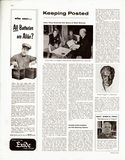
Walt Disney (page 25) looked up from the manuscript which his daughter Diane had asked him to read, and he said to Pete Martin, Diane's collaborator, "I've been written up a great many times, but this is the first time the warm, intimate, true story has come through." Then he paid a tribute which in Martin's experience, despite all his years of writing about people, was almost unique; Disney's eyes filled with tears. Disney is a man of deep and swift sentiment, as the true geniuses so often are. Indeed, he can cry at a good movie—he walks out on bad movies, which perhaps enables him not to cry at them. "In factual writing," Martin reflects, "it's not too hard to make people laugh. But to bring that eye mist is something else again." The tears made Martin happy. Diane too.
They were sitting as you see them in the picture. Behind them is the Disney recreation house, before them the swimming pool. Beyond the pool, the lawn sweeps away to the friendly home over which Mrs. Disney presides. Disney was reading passages in the manuscript in which Diane was tenderly relating child-hood memories of her father, telling things that he didn't know she knew or had thought about him.
It made Martin recall a similar experience of his own when he and his son, Peter, now on the editorial staff of Time magazine, collaborated in the Post in 1952 on a talk-back-and-forth piece about Dartmouth College while Peter was a student there. "What the young ones think sort of bowls you over," says Martin; and Disney got bowled over and over. In the end he wrote a letter to Editor Ben Hibbs, glowing about what a sensitive job Diane and Martin had done. Martin latched onto the letter, and let's make a memo to look into Martin's cherished-souvenir department some week—it must be a young museum by now.
Of course, in this unusual daughter-writer hookup, the essence of success had to be co-operation by the father, and that came freely. Late each afternoon, after Diane and Martin had played throw-and-catch with words, Disney would knock off at the studio and come to listen in. "That wasn't easy for him—he has a terrific work schedule," Martin comments. "He didn't do it for me, but because of his deep interest in Diane's writing project. Diane and Sharon—he's crazy about his daughters." Which brings to mind (this being football season) that Diane's husband, Ron Miller, is currently a rookie end with the Los Angeles Rams, and one sees by the papers that he's a dandy at the sport with the crazy-bounding ball.
Early in the talk-it-out task Martin discovered that there were times when he should keep his mouth shut and others when he should do business with it. Often the problem of the told-to person is to deftly guide conversation, helpfully stimulating the teller to tell all. Diane liked it that way. But when her dad would sometimes offer a comment, he didn't go for piloting interjections—they untracked his thinking. So with Disney, Martin occasionally tried just dropping a question to get him started and then jumping back out of the way; and this worked fine.
Only once did Diane and her father get into a hassle. This was regarding the anecdote in which Disney, when Diane was in her teens, asked her what he could put in Disneyland to appeal to teen-age girls, and the admirable answer was alleged to have been "Boys." Diane said she didn't say it; Disney said she did. For a brief time they did-didn'ted; then just wound up in a well-maybe draw. Not really much of a hassle, was it?